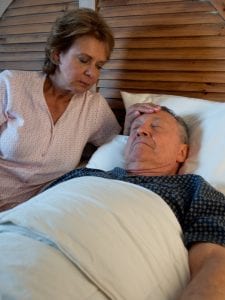Welcome to the educational program Late Stages: Hospice and Bereavement. This program will discuss end-of-life and hospice issues during the late and terminal stages of Alzheimer’s disease, provide information about hospice services and advance directives, and discuss the bereavement process. .
. . .
This is Lesson 24 of The Alzheimer’s Caregiver. You may view the topics in order as presented, or click on any topic listed in the main menu to be taken to that section. We hope that you enjoy this program and find it useful in helping both yourself and those you care for. There are no easy answers when it comes to the care of another, as every situation and person is different. In addition, every caregiver comes with different experiences, skills, and attitudes about caregiving. Our hope is to offer you useful information and guidelines for caring for someone with dementia, but these guidelines will need to be adjusted to suit your own individual needs. Remember that your life experiences, your compassion and your inventiveness will go a long way toward enabling you to provide quality care.
Let’s get started.
Prefer to listen to this lesson? Click the Play button on the playlist below to begin.
Alzheimer’s Disease Progression
 Alzheimer’s disease is a progressive illness. As the disease progresses, individuals lose more and more functional abilities and will need increasing levels of supervision and assistance in all aspects of their lives. People live an average of 8 to10 years after diagnosis, however, some people may live and require care for as long as 20 years.
Alzheimer’s disease is a progressive illness. As the disease progresses, individuals lose more and more functional abilities and will need increasing levels of supervision and assistance in all aspects of their lives. People live an average of 8 to10 years after diagnosis, however, some people may live and require care for as long as 20 years.
It is important to note that although Alzheimer’s disease has a predictable pattern of mental, functional, and behavioral deterioration, not all people with the illness will progress in exactly the same way. As functional abilities deteriorate, the type of care people need changes considerably over time. Because the course of the illness is long and changes are gradual, “staging” its progression is useful in counseling families about what to expect in planning for care. Many different staging methods for the progression of dementia have been developed. The most common classification of stages uses the terms: early, middle, late and end stages.
Stages of Alzheimer’s Disease
In the early stage of Alzheimer’s disease, affected individuals begin to forget appointments, names, and places. They may lose valuable items and may get lost in less familiar places. These problems are often attributed to stress, illness or fatigue. Depression often results from these early losses. This stage typically lasts 2 to 3 years.
In the middle stages, individuals will have difficulty with managing money, legal affairs, workplace affairs, and driving. Home maintenance, housekeeping and cooking will be frustrating and perhaps dangerous. They will have difficulty functioning in new environments and can get lost even in familiar environments. At this point, personality changes become noticeable, such as hostility, paranoia, swearing, or inappropriate sexual behavior. Though they may neglect their personal hygiene, when reminded, they are able to manage most of their own bathing, dressing, grooming, and self feeding. This stage typically lasts 3 to 4 years.
In the late stages, individuals will have increasing difficulty with their activities of daily living, including bathing, grooming, and toileting. They will have difficulty understanding their environment, understanding directions and in making themselves understood. Communication difficulties and loss of abilities can lead to frustration, anger, and wandering. Sleep can also be affected by nighttime awakenings, wandering, hallucinations and daytime napping. At this stage of the illness, individuals cannot be left alone and need 24 hour care. Depending on the age and health of the individual, this stage can last anywhere from 4 to 7 years.
The terminal or end stage of Alzheimer’s disease is the stage when individuals are not be expected to live much longer and hospice care might be considered. No longer ambulatory, they may need complete bed care. They will become incontinent, lose weight and have difficulty chewing their food and communicating. They will no longer have the ability to recognize people or objects, though they may have moments of lucidity. Because it is so debilitating, it is rare for this stage to last more than a year. Death may come about from heart failure, pneumonia or other infection ,or complete brain shut down of vital functions.
 It is often difficult to know how close an individual is to death. A person at the final stages will not be able to walk or talk, sit up alone, or have control of bowel or bladder. Muscle contractions and inability to swallow put the person at risk of malnutrition. There are also potential complications of being bedridden, such as pneumonia and skin breakdown. The last stage of Alzheimer’s disease requires extensive care for the person from feeding to physical therapy to toileting and bathing. This is a stressful time for the caregiver who must make many difficult decisions. They must grapple with questions such as whether or not to insert feeding tubes, treat a bout of pneumonia, or put the person on a ventilator.
It is often difficult to know how close an individual is to death. A person at the final stages will not be able to walk or talk, sit up alone, or have control of bowel or bladder. Muscle contractions and inability to swallow put the person at risk of malnutrition. There are also potential complications of being bedridden, such as pneumonia and skin breakdown. The last stage of Alzheimer’s disease requires extensive care for the person from feeding to physical therapy to toileting and bathing. This is a stressful time for the caregiver who must make many difficult decisions. They must grapple with questions such as whether or not to insert feeding tubes, treat a bout of pneumonia, or put the person on a ventilator.
Because Alzheimer’s disease affects older people, who usually have other medical issues, death usually occurs as a result of some other medical condition, such as heart disease or infections. However, the brain is the master organ and controls all functions of the body, so death may come about simply due to a complete shutdown of the brain.
Let’s look at a situation with Mary and Robert, who has entered the late stages of Alzheimer’s disease.

Robert had been cared for at home until he began to have difficulty speaking and controlling his bowel and bladder. At that point, Mary and the family decided to place him in a residential care facility, and he did well there for several months.As time passed, he required more and more assistance with daily functions and his speech continued to decline. He sometimes recognized Mary, but couldn’t recall her name and didn’t recognize other members of the family. He was increasingly unsteady on his feet and had taken several falls. At some point, he stopped speaking altogether and began to have difficulty swallowing.He spent his time in bed or in a wheelchair for mobility, but would moan and cry during transfer. He is now unable to swallow, is losing weight, and screams and groans when he is moved at all. He does not seem to recognize anyone. And for the past 24 hrs, he has also had a mild fever of unclear origin.
What should Mary do for Robert at this point?- A. Initiate artificial feedings
- B. Admit Robert to a hospital and obtain intensive nursing care
- C. Place Robert in hospice care
Case Study 1 Answers:
Choice A: Initiate artificial feedings, is not the best option.
Artificial feedings may seem like a good, option because Robert is unable to swallow and refuses food. However,artificial feedings do not address his other issues and may be of questionable benefit given the discomfort and risks artificial feedings can pose.
Choice B: Admit Robert to a hospital and obtain intensive nursing care, is a possible option.
Hospitalization of individuals with Alzheimer’s disease often occurs due to fever, difficulty swallowing, or breathing difficulties that might indicate pneumonia or other lung or heart issue.It would not be unreasonable to hospitalize Robert to find the source of his fever and treat it as well as address his inability to swallow. It is tempting to think that hospitalization with aggressive treatment might “bring Robert back.”
But the truth is that transferring Robert from the care facility to a hospital would be traumatic for him and could result in a deterioration of any retained functions in mobility, toileting, feeding, and communication. His low grade fever could be caused by something that can be treated in the care facility, such as dehydration, pneumonia, or a urinary tract infection.Trying to treat his health issues in the care facility avoids the stress of moving him to a hospital.
Choice C: Place Robert in hospice care, is the best choice in this situation.
Given the late stage of Robert’s disease and his current condition, contacting a hospice care organization is probably the best thing Mary could do for Robert. With hospice care, physicians can investigate the cause of the fever and swallowing problems and develop a plan with the input of the family to relieve his discomfort and promote the optimal quality of life for his last days. This emphasis on providing comfort to the person with the illness rather than aggressive treatment is referred to as palliative care. Hospice services have close involvement with the family and provide support for them in anticipation of the death of their loved one.
Late Stages Care: Artificial Feeding
Let’s look more closely at these late and end-stage care alternatives, starting with artificial feeding. There are 3 main types of artificial feeding available for someone who is unable to self feed: nasogastric tube feeding, percutaneous endoscopic gastrostomy, and Total Parenteral Nutrition.
 Nasogastric tube feeding provides nutrition in liquid form through a thin, plastic tube called a nasogastric tube. The tube is threaded into the stomach through the nose and is taped in place. People may find the tube irritating and can easily pull it out, resulting in uncomfortable reinsertions.
Nasogastric tube feeding provides nutrition in liquid form through a thin, plastic tube called a nasogastric tube. The tube is threaded into the stomach through the nose and is taped in place. People may find the tube irritating and can easily pull it out, resulting in uncomfortable reinsertions.
The percutaneous endoscopic gastrostomy, or PEG, tube, also delivers nutrition in liquid form, but placement of this tube requires a surgical procedure. The tube is inserted through the upper abdomen and stomach wall and fixed into place, so that it is relatively stable and less likely to be pulled out. Because this method requires incisions in skin and internal tissues, there is a risk of infection at these sites.
Total parenteral nutrition, also referred to as TPN, bypasses the digestive system and delivers nutrients by intravenous infusion directly into the blood stream.
Nasogastric and PEG methods of providing nutrition are useful in certain circumstances on a temporary basis, but are generally not advised for those with Alzheimer’s disease in the terminal stage.
TPN can be a safe and effective method of nutritional support for some patients, but for individuals with Alzheimer’s disease, it can add to their confusion and discomfort with long term use.
There is now considerable evidence that feeding artificially with any of these methods does not prolong life, reduce the risk of infection or pressure ulcers, or improve the person’s function or memory.
At the same time, the procedures can cause pain, discomfort, agitation, and decrease the quality of life. Placement of artificial feeding devices must often be completed under sedation and physical restraint. The tubes can be uncomfortable and result in medical complications such as infections. These methods of feeding also deprive the individual of touch, taste and smell sensations as well as the personal contact that feeding assistance provides.
Artificial feeding can also increase fluid in the lungs, causing difficult breathing. In the terminal stages of Alzheimer’s disease, hunger and thirst are not strong
drives. Cessation of food intake results in the release of endorphins or natural chemicals that reduce pain. Feeding tubes and hydration block the release of these endorphins and can result in weeks of “unnecessary suffering.”
 Studies have shown that hospitalization and other aggressive treatments such as artificial feeding have low rates of success among persons with dementia and can have undesired outcomes that can hasten functional and cognitive decline and even death. Hospitalization of elders who are not even diagnosed with dementia can cause or increase confusion and incontinence, loss of appetite and vulnerability to falls and fractures.
Studies have shown that hospitalization and other aggressive treatments such as artificial feeding have low rates of success among persons with dementia and can have undesired outcomes that can hasten functional and cognitive decline and even death. Hospitalization of elders who are not even diagnosed with dementia can cause or increase confusion and incontinence, loss of appetite and vulnerability to falls and fractures.
Another risk of hospitalization is exposure to infectious diseases. Individuals with dementia are particularly susceptible to infections due to their reduced immune response, swallowing difficulties, immobility and their inability to make their needs known. Because many of the patients in hospitals have infections, there is greater risk of catching serious infections in hospitals than in the general community, especially among the elder and immune-compromised. In fact, studies have shown better long term outcomes with treating pneumonia and other infections at home or in a care facility rather than in a hospital. For these reasons, some people include a “do not hospitalize” clause in their “advance directives.”
Some people include a “Do Not Resuscitate” clause in their advance directives. For those people who do not want aggressive treatment to prolong life through artificial means, Do Not Resuscitate orders advocate a respectful and dignified death and allows the family meaningful time with their loved one at the end of the person’s life.
 Hospice care is a service that provides what is referred to as palliative care for individuals who are nearing the end of their lives. The goal of palliative care is a dignified death for the individual while alleviating pain and suffering. This is accomplished through the provision of comfort and symptom relief in the terminal stage of an illness and the avoidance of artificial feeding, and aggressive treatments such as hospitalization, dialysis and artificial resuscitation. It includes management of pain and involvement of physicians and nurses.
Hospice care is a service that provides what is referred to as palliative care for individuals who are nearing the end of their lives. The goal of palliative care is a dignified death for the individual while alleviating pain and suffering. This is accomplished through the provision of comfort and symptom relief in the terminal stage of an illness and the avoidance of artificial feeding, and aggressive treatments such as hospitalization, dialysis and artificial resuscitation. It includes management of pain and involvement of physicians and nurses.
Hospice care services also provide support to the family through the terminal illness and dying process. The focus of hospice is caring, not curing, and to provide the highest quality of life during whatever time remains. Hospice care does not hasten or postpone death. It can be provided in the home, residential facility, hospital, or professional hospice facility.
Palliative care and hospice services are the most effective and respectful approach for advanced stages of Alzheimer’s disease. “Family members should never be made to feel guilty in making a decision to allow a person with Alzheimer’s disease to die naturally” says Dr. Stephen Post, Bioethicist at Case Western School of Medicine.
Individuals are eligible for Hospice Care if they have Medicare Part A coverage through their Social Security plan. They must be diagnosed by their physician to have a life expectancy of six months or less with no treatment to reverse this. They must also waive the right for Medicare to pay for other services to treat the terminal illness, such as hiring an outside counselor or therapist.
Hospice care was formalized as a humane approach to end-of-life care in the US under Section 1861 (dd) of the Social Security Act,
Due to the seriousness of Alzheimer’s disease, both for those with the illness and for their families, hospice care is available to Alzheimer patients. However, applying this service to Alzheimer patients has been hampered because of difficulty satisfying the “six month” life expectancy requirement. There is, at present, no clear-cut agreement with Medicare authorities on the exact criteria for life expectancy for persons with Alzheimer’s. The closest guideline is based on the FAST (Functional Assessment Staging) scale developed by Dr. Barry Reisberg. Survival time of six months or less, would include those individuals at stage 7C or greater.
At stage 7C, an individual would have no control over bowel or bladder, would have little or no speech, and would be unable to walk. The physician would look for additional signs such as difficulty swallowing, refusing food, and other neurological signs as indicators. It is ultimately up to the physician to make the judgment about stage and life expectancy.
 “Hospice care” agencies provide specific services to terminally ill individuals through formal arrangements with physicians and family members established in a written plan that is periodically reviewed by the individuals’ attending physicians and the hospice agency team. The list of services includes nursing care provided by or under the supervision of a registered nurse, physical or occupational therapy, speech-language pathology services, certified home health aide services, and medical social services under the direction of a physician.
“Hospice care” agencies provide specific services to terminally ill individuals through formal arrangements with physicians and family members established in a written plan that is periodically reviewed by the individuals’ attending physicians and the hospice agency team. The list of services includes nursing care provided by or under the supervision of a registered nurse, physical or occupational therapy, speech-language pathology services, certified home health aide services, and medical social services under the direction of a physician.
Physician services, medical supplies, equipment, and medication are included under hospice care.
Short-term inpatient care includes respite care on an intermittent, non-routine, and occasional basis but may not be provided consecutively for more than five days. Counseling for the family with regard to grief and bereavement is also available.
Hospice services can be provided in a free-standing Hospice Care facility, in the person’s home, or in a residential facility. Medicare and Medicaid insurances will cover the cost except for 5% of medications and 5% per day for Respite Care. There are no deductibles.
Hospice is available for 6 months, but can be a little longer if justified by a physician and funding is approved. The 6 months can be divided into two periods of 3 months if the illness and the condition of the individual warrants it.
For additional information about hospice care, click on the provided links www.cms.hhs.gov www.medicare.gov www.nhpco.orgHospice Care Process (Part 3)
If the family is agreeable to a hospice program, the physician will initiate the process by making a referral to a hospice agency. A representative of the agency, most likely a registered nurse, will visit the person with Alzheimer’s and the family, to make an assessment of the affected individual’s condition and needs. The nurse will report the findings to the physician who will order the appropriate services. The hospice nurse will meet with the family and develop a plan based on hospice recommendations.
The plan may include arranging for a nursing assistant to visit and bathe the person, provide oral care and change bed linen. It will include periodic assessments by the hospice nurse with revision of plans accordingly. The nurse will also visit with the family members to explain the individual’s dying process and provide grief counseling. Medication for pain and comfort will be prescribed. Though aggressive feeding will not be attempted, food, and particularly fluid, will be offered as long as the individual will partake of it. Hospice service will assist the family to obtain spiritual support and, at the very end of life, can counsel the family to obtain autopsy and funeral services, though hospice would not be involved in these arrangements.
Advance Directives
 Writing “Advance Directives” is a legal way for individuals to express their wishes about their medical care at the end of life. If such documents are not in place when a person with dementia approaches death, family members must make these decisions based on what they believe their loved one would wish. Setting up an advance directives document is one way to clearly establish one’s wishes.
Writing “Advance Directives” is a legal way for individuals to express their wishes about their medical care at the end of life. If such documents are not in place when a person with dementia approaches death, family members must make these decisions based on what they believe their loved one would wish. Setting up an advance directives document is one way to clearly establish one’s wishes.
Advance directives will change as the individual advances in years. For example, a young male head of household who has an accident or other emergency may wish to have every effort made to save his life, whereas, an 85 year old man, who is bed bound with a chronic illness my choose to forego any aggressive measures or treatments.
It is suggested that every adult should have completed a “living will” and a “durable power of attorney for health care.” The living will indicates what treatments they wish to have and what they wish to forego. Any person has the legal right to limit, refuse, or discontinue medical treatments. Establishing someone with durable power of attorney is simply a way to designate a person, such as a family member or a friend, to make decisions for you when you are no longer able. In some states the person with power of attorney for health care is referred to as the “health care guardian.”
Most states have an approved form for a living will and designation of power of attorney. These can be obtained from the State Agency on Aging. When completed, copies of the documents should be given to the physician, the hospice agency, and to family members.
 Many people are interested in having an autopsy following the death of their family member with Alzheimer’s. This can be useful for survivors to help them better understand the particular illness and how it might affect their own health. Survivors may also wish to help scientists understand and treat the disease as a to benefit society and the advancement of medicine.
Many people are interested in having an autopsy following the death of their family member with Alzheimer’s. This can be useful for survivors to help them better understand the particular illness and how it might affect their own health. Survivors may also wish to help scientists understand and treat the disease as a to benefit society and the advancement of medicine.
There are various brain research institutions in the United States that will perform brain autopsies. The process requires prior agreement to donate a brain to a particular research organization. A permission form must be completed and copies provided to the facility where the individual is being cared for, the funeral home, and the attending physician. A specialist must remove the brain and prepare it for transport to the research facility.
If individuals have strong feelings about whether or not they want an autopsy performed on them, they can indicate this in their living will and durable power of attorney for health care.
To find an institution in your area that will perform brain autopsies, contact the Alzheimer’s Association.
Click here to find an institution in your area that will perform brain autopsies.
Grief and Bereavement
Now let’s discuss grief and bereavement following the death of someone with dementia.
 Because Alzheimer’s disease and other dementias follow a long, unrelenting course, the family’s grief and bereavement experience is quite varied and complex. Families are often emotionally conflicted in their reaction to the death of their loved one with dementia. Their emotions may be a combination of grief, relief, and guilt.
Because Alzheimer’s disease and other dementias follow a long, unrelenting course, the family’s grief and bereavement experience is quite varied and complex. Families are often emotionally conflicted in their reaction to the death of their loved one with dementia. Their emotions may be a combination of grief, relief, and guilt.
The grief may be the culmination of years of grief over the gradual loss of the person as she or he was known. The relief may be due to the knowledge that the person will no longer suffer and because the burden and stress of caregiving have ended. However, despite the understandable relief, families may also feel very guilty for feeling that way and question whether they did everything they should have done for the deceased individual.
In Alzheimer’s disease, the experience of grieving can begin early in the illness through loss of the person’s various capacities and personality changes. As the person loses capacities and develops personality changes, the family caregiver experiences the loss of companionship, assistance with tasks, and a love relationship over the course of many years. That is why this is sometimes referred to as the “long good-bye.”
Grief and Bereavement (Continued)
 The paradox about this long bereavement and grief process is that caregivers and family members often do not allow or recognize it. Because the course of the illness is so long and the care so demanding, they often become so busy and preoccupied with the caregiving role that they do not acknowledge their grief. When death does come, the reactions can be unexpected and profound. In some ways, it is like the person with dementia died a long time ago with a prolonged good-bye process. One wife caregiver said “I went to the church, knelt down and thanked God that he had been taken him”. Another said: ‘I couldn’t cry when he died. I think I was all cried out”. And another “I didn’t know what to do with myself.”
The paradox about this long bereavement and grief process is that caregivers and family members often do not allow or recognize it. Because the course of the illness is so long and the care so demanding, they often become so busy and preoccupied with the caregiving role that they do not acknowledge their grief. When death does come, the reactions can be unexpected and profound. In some ways, it is like the person with dementia died a long time ago with a prolonged good-bye process. One wife caregiver said “I went to the church, knelt down and thanked God that he had been taken him”. Another said: ‘I couldn’t cry when he died. I think I was all cried out”. And another “I didn’t know what to do with myself.”
Studies have shown differing acceptance of death depending on the length of the illness and dying process. A sudden death and an extremely prolonged death, such as in Alzheimer’s disease, can be more difficult to accept than a death that is expected yet there is time to reminisce, resolve relationships, plan for family welfare, and to say goodbye. With a sudden death, family members are not afforded the opportunity to say their goodbyes and are left with regrets of things they should have done or said to the person. With a prolonged death, such as with Alzheimer’s disease, the journey is so long and difficult that caregivers often get sick and feel exhausted, angry, or just numb from the ordeal.
 Let’s look at the course of the illness and consider what may be going on to create these mixed emotions.
Let’s look at the course of the illness and consider what may be going on to create these mixed emotions.
Before the person is diagnosed, changes in function and behavior can cause difficulties in a marital relationship. The time leading up to a diagnosis is a stressful time. But when a diagnosis is made, caregivers, particularly spouses, may experience relief. Individuals with the illness may also feel relief that the confusion and disorganization in their lives have a name.
As the disease progresses slowly over many years, there are losses of the functions and capacities that make up the individual’s sense of self and personality. Early in the illness, the ability to fulfill certain role responsibilities, such as a wife cooking a meal for her husband or a husband mowing the lawn or fixing the car, will be lost. When this happens, the partner must take up the tasks that are neglected. You could say that the caregiver is bereaved of the person’s role partnership, and thus the beginning of the “bereavement” and “grief” over the loss.
The grief and bereavement process progresses as the individuals and their caregivers suffer losses over the course of the illness. As the affected individuals lose the abilities to speak and understand, their caregivers lose communication with them. As the person loses the ability to recognize family and friends, companionship is lost. When difficult behaviors and personality changes occur, the person may seem like a stranger rather than the person family and friends knew. When self-care declines and is totally lost, caregivers are completely occupied with providing care and so lose their own privacy and freedom. There is a point at which the person may seem to some as devoid of their “personhood,” and caregivers feel a sense of total abandonment.
 Feelings of guilt can develop for a few reasons. It is not uncommon for families and caregivers to pray for the death of their loved one. The tragic nature of the illness creates a wish for the suffering to end. If families are informed and supported during the illness, particularly the final days, they may be able to accept their own feelings, but they are often left with guilt and regret.
Feelings of guilt can develop for a few reasons. It is not uncommon for families and caregivers to pray for the death of their loved one. The tragic nature of the illness creates a wish for the suffering to end. If families are informed and supported during the illness, particularly the final days, they may be able to accept their own feelings, but they are often left with guilt and regret.
If they do not feel guilty for “wishing for death”, they may feel guilty for the times they shouted at their loved one or when they placed them in a care facility. Families can feel guilty because they didn’t visit as often as they should have or weren’t there at the moment of death. The truth is, most families do all that they can for their affected family member. Families need to accept that their loved one will continue to decline and that they will grieve each loss of ability and change in personality along the way.
Some have referred to death from Alzheimer’s disease as “the funeral that never ends.” We grieve when we see our loved ones rummaging in a drawer for something they hid the day before, when we see them wandering looking for something, when we observe them desperately trying to make sense of their world, when we see them in a wheelchair for the first time, and when they can no longer swallow food. When they no longer recognize us, we will grieve. And when our loved one takes their last breath, we will grieve, but with a sigh of “relief” that the ordeal is over and they are at rest.
These mixed feelings are understandable given the month to month and day to day turmoil of caring for someone with Alzheimer’s disease. When, for 8 to 10 years, a caregiver’s life has been completely focused on the arduous work of caregiving, she or he can be left feeling empty,  useless, and depressed following the care recipient’s death. So, it is important that the extent of the grief be recognized and dealt with in a healthy way.
useless, and depressed following the care recipient’s death. So, it is important that the extent of the grief be recognized and dealt with in a healthy way.
Three ways of resolving the complex emotions and reactions have been identified.
A person can reengage with life through family and friends.
Others may feel the need to devote themselves to a cause or service, such as volunteering for the Alzheimer’s Association or other worthy organization.
However, some may truly feel that their life has no purpose anymore and sink into a depression. Let’s discuss these three responses in more detail.
Resolving Complex Emotions (Part 2)
 Individuals who are younger, who have been assertive in understanding the illness and the care required, who may have strong spiritual beliefs and affiliations, and have supportive families, are more likely to be able to reengage following their loved one’s death. They will be more able to come to terms with any feelings of guilt that they may have.
Individuals who are younger, who have been assertive in understanding the illness and the care required, who may have strong spiritual beliefs and affiliations, and have supportive families, are more likely to be able to reengage following their loved one’s death. They will be more able to come to terms with any feelings of guilt that they may have.
Honoring the loved one’s life through a rite of passage, whether through a funeral, an old fashioned wake, or other form of remembrance, can help diminish the pain. Allowing the healing power of time and new experiences will soften the rough spots in the caregiver’s memory and allow re-engagement.
Additionally spouses can meet other spouses either through support groups or when visiting their loved ones in a care facility and form friendships that, following their loved one’s death, can grow and sometimes even lead to romance and a new life.
Resolving Complex Emotions (Part 3)
Another approach that bereaved spouses or family members may use to come to terms with their grief and guilt is to commit themselves to the noble cause of service to others. This can happen when a caregiver has developed close ties with others in the “same boat”, such as through a support group or web site discussion group.
 The Alzheimer’s disease in-person support groups that are available all over the world are particularly powerful in their format of meeting regularly with others who share similar worries, questions, and support one another. Some who have attended such groups during their caregiving years continue to attend following the death of their loved one and engage in volunteer work with the organization, even serving as members and officers with the organization’s “board”.
The Alzheimer’s disease in-person support groups that are available all over the world are particularly powerful in their format of meeting regularly with others who share similar worries, questions, and support one another. Some who have attended such groups during their caregiving years continue to attend following the death of their loved one and engage in volunteer work with the organization, even serving as members and officers with the organization’s “board”.
It seems a natural outcome for ex-caregivers to serve others, drawing from their experiences and providing the support to others that they received when they needed it.
Many caregivers receive information and guidance from various dementia organizations’ Internet chat groups, message boards, and blogs. These internet forums provide another avenue for caregivers to contribute their experiences and provide support and advice to others.
Volunteer endeavors do not have to be related to dementia organizations. Other possibilities include volunteering in a local hospital, a food kitchen, or a homeless shelter. The work involved in these services can provide structure to one’s schedule, satisfaction of accomplishment, and a sense of purpose. New acquaintances and friends will develop as well.
 There are some circumstances in which bereaved caregivers seem unable to come to terms with their loss when their loved one dies. This is more likely when the caregivers are older and have medical problems of their own that they have not been able to attend to properly. Even younger, healthier individuals, an adult daughter, for example, who have not been assertive in seeking help and who have not had support from other family members, may develop depression following the death of a parent. They can become mired down in feelings of guilt, loss, anger, and grief.
There are some circumstances in which bereaved caregivers seem unable to come to terms with their loss when their loved one dies. This is more likely when the caregivers are older and have medical problems of their own that they have not been able to attend to properly. Even younger, healthier individuals, an adult daughter, for example, who have not been assertive in seeking help and who have not had support from other family members, may develop depression following the death of a parent. They can become mired down in feelings of guilt, loss, anger, and grief.
The depression of unresolved grief can lead to suicide attempts or poor health. Caregivers who have, for whatever reason, not received the assistance they needed during their caregiving time may need help reaching out for assistance during their grief. They should be strongly encouraged, even taken by the hand, to join a bereavement support group or to get individual counseling. This level of grief may not resolve by itself.
 In summary, care alternatives during the end stage of Alzheimer’s disease include artificial feeding, hospitalization, and hospice care.
In summary, care alternatives during the end stage of Alzheimer’s disease include artificial feeding, hospitalization, and hospice care.
There are 3 main types of artificial feeding available to those who cannot eat: nasogastric tube feeding, percutaneous endoscopic gastrostomy, and total parenteral nutrition or TPN. Hospitalization and aggressive treatments for a person at the end-stage of Alzheimer’s have risks, including greater loss of function, risk of infections and death
Hospice care provides comfort at the end of a person’s life and support for the family. End-of-life planning should include advance directives and assignment of a durable power of attorney for health care.
Caregivers grieve throughout the course of Alzheimer’s disease for various losses.
Ways that caregivers have found to come to terms with their caregiving experience and the death of their loved one include engaging back with family and friends and committing to a cause. And some may need to obtain counseling for depression and unresolved grief.
← Previous Lesson (Late Stages: Communication and Activities)
→ Next Lesson (Late Stages: Personal Care)
. . .
Written by: Catherine M. Harris, PhD, RNCS (University of New Mexico College of Nursing)
Edited by: Mindy J. Kim-Miller, MD, PhD (University of Chicago School of Medicine)
References:
- Bernick L, Nisan C, Higgins M. (2002). Care of the body: maintaining dignity and respect. Perspectives.;26(4):10-4.
- Boyd CO and Vernon GM. (1998). Primary care of the older adult with end-stage Alzheimer’s disease. The Nurse Practitioner. 23 4:63–83.
- Brashler R; Savage TA; Mukherjee D; Kirschner KL. (2007). Ethics in practice. Feeding tubes: three perspectives. 14(6): 74-7.
- Charlson ME, Pompei P, Ales KL and MacKenzie CR. (1987). A new method of classifying prognostic comorbidity in longitudinal studies:Development and validation. Journal Of Chronic Disease. 40(5):373–383.
- Di Giulio P, Toscani F, Villani D, Brunelli C, Gentile S, Spadin P. (2007). Dying with advanced dementia in long-term care geriatric institutions:a retrospective study. J Palliat Med. 2008 Sep;11(7):1023-8.
- Eisdorfer C, Cohen D, Paveza GJ, et al. (1992). An empirical evaluation of the global deterioration scale for staging Alzheimer’s disease.American Journal of Psychiatry 149(2):190–194.
- Epps, C.D. (2001). Recognizing pain in the institutionalized elder with dementia. Geriatric Nursing, 22 (2), 71-77.
- Gillick MR; Volandes AE. (2008). The standard of caring: why do we still use feeding tubes in patients with advanced dementia? Journal of the American Medical Directors Association; 9(5): 364-7.
- Hertogh CM, de Boer ME, Dröes RM, Eefsting JA. (2007). Would we rather lose our life than lose our self? Lessons from the Dutch debate on euthanasia for patients with dementia. Am J Bioeth. 7(4):48-56.
- Hoffman, SB & Kaplan M. (1996). Special care programs for people with dementia. Health Professions Press.Baltimore.
- Kuhn DR, Ortigara A, Farran CJ. (1997). A continuum of care in Alzheimer’s disease. Advanced Practice Nursing Quarterly. 2(4):15–21.
- Lamb VL, Sloan FA, Nathan AS (2008). Dementia and Medicare at life’s end. Health Serv Res. 43(2):714-32.
- Lopez-Tourres F, Lefebvre-Chapiro S, Fétéanu D, Trivalle C. (2008). [Palliative care and Alzheimer disease.] Rev Med Interne. 2008 Oct 31.[Epub ahead of print]
- Luchins DL, Hanrahan P, Murphy K. (1997) Criteria for enrolling dementia patients in hospice. Journal American Geriatric Society 45(9):1054–1059.
- Modi, Seema , Moore, Cassandra (2005). Which late-stage Alzheimer’s patients should be referred for hospice care? Journal of Family Practice; 54:984-986.
- Munn JC, Hanson LC, Zimmerman S, Sloane PD, Mitchell CM. Is hospice associated with improved end-of-life care in nursing homes and assisted living facilities? J Am Geriatr Soc. 2006 Mar;54(3):490-5.
- O’Donovan, S. (1996). A validation approach to severely demented clients. Nursing Standard. 11 (13-15), 48-52.
- Paniagua MA; Paniagua EW. (2008). The demented elder with insomnia. Clinics in Geriatric Medicine, 24(1): 69-81.
- Pinderhughes ST, Morrison RS. (2003). Evidence-based approach to management of fever in patients with end-stage dementia. J Palliat Med.;6(3):351-4.
- Powers BA, Watson NM. Meaning and practice of palliative care for nursing home residents with dementia at end of life. Am J Alzheimers Dis Other Demen. 2008 Aug-Sep;23(4):319-25. Epub 2008 May 4.
- Prigerson, HG (2003). Costs to Society of Family Caregiving for Patients with End-Stage Alzheimer’s Disease. N Engl J Med. 2003 Nov 13;349(20):1891-2.
- Sally Planalp a; Melanie R. Trost (2008). Communication Issues at the End of Life: Reports from Hospice Volunteers Health Communication.23(3):222 – 233.
- Schonwetter RS; Han B; Small BJ; Martin B; Tope K; Haley WE. (2003). Predictors of six-month survival among patients with dementia: an evaluation of hospice Medicare guidelines. American Journal of Hospice & Palliative Care 20(2): 105-13.
- Triplett P, Black BS, Phillips H, et al. (2008). Content of advance directives for individuals with advanced dementia. J Aging Health. 2008Aug;20(5):583-96.
- Tully MW, Matrakas KL, Muir J, Musallam K. (1997). The eating behavior scale: a simple method of assessing functional ability in patients with Alzheimer’s disease. Journal Of Gerontological Nursing 23:9–15.
- Vesey S; Leslie P; Exley C (2008). A pilot study exploring the factors that influence the decision to have PEG feeding in patients with progressive conditions. Dysphagia; 23(3): 310-6.
- Volicer L. (2005). End-of-life Care for People with Dementia in Residential Care Settings. Alzheiemer’s Association. Retrieved from http://www.alz.org/national/documents/endoflifelitreview.pdf.
- Watts V; Turnpenny B; Brown A (2007). Feeding problems in dementia. Geriatric Medicine, 37(8): 15-6, 18-9.

